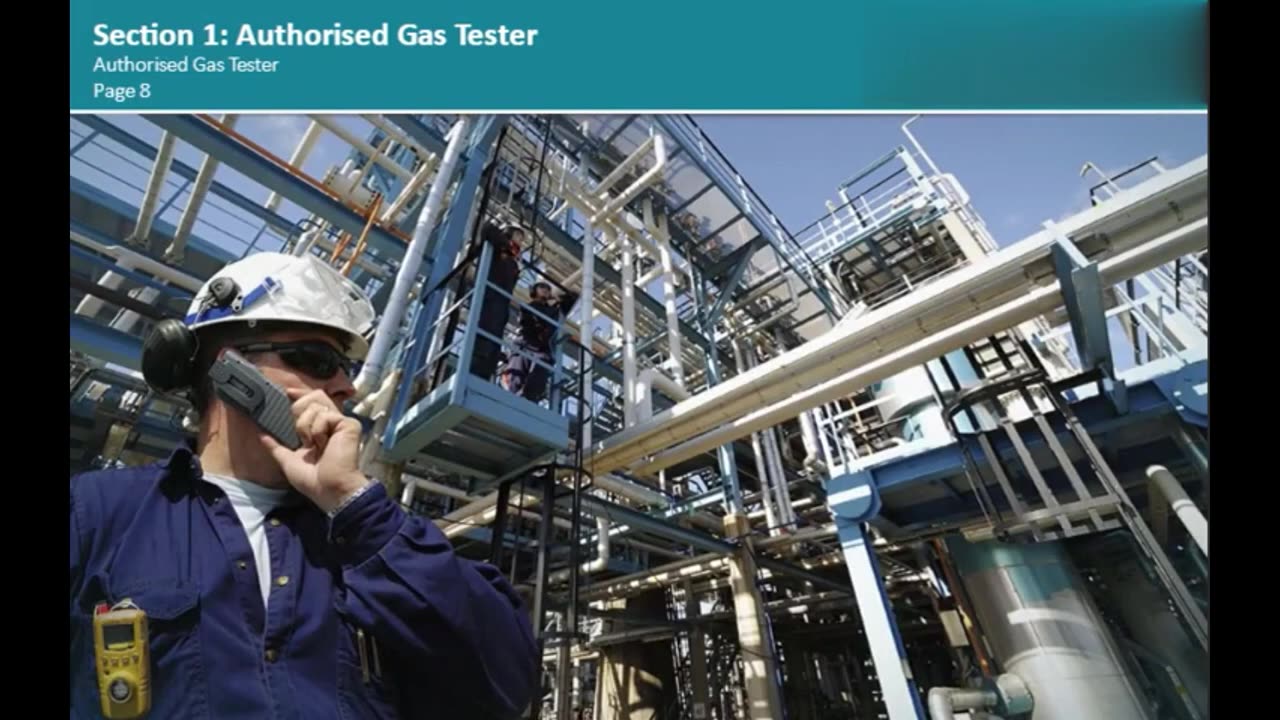Premium Only Content

Authorized Gas Tester Introduction
### **Introduction to Authorized Gas Tester (AGT)**
An **Authorized Gas Tester (AGT)** is a trained and certified individual responsible for testing and monitoring atmospheric conditions in hazardous environments. This role is crucial in industries like oil and gas, construction, manufacturing, and confined space operations, where unsafe gas levels can pose significant risks to health, safety, and operations.
---
### **Purpose of Authorized Gas Testing**
1. **Identify Hazardous Gases**: Detect and monitor flammable, toxic, or oxygen-deficient atmospheres.
2. **Ensure Safe Entry**: Verify that conditions are safe for workers to enter confined spaces or perform high-risk activities.
3. **Monitor Work Areas**: Continuously check gas levels during tasks like hot work, cleaning, or maintenance.
4. **Compliance**: Meet legal and industry standards for workplace safety.
---
### **Key Responsibilities of an Authorized Gas Tester**
1. **Gas Testing and Analysis**
- Measure concentrations of gases such as oxygen (O₂), carbon monoxide (CO), hydrogen sulfide (H₂S), and hydrocarbons.
- Use portable gas detectors or fixed monitoring systems effectively.
2. **Risk Assessment**
- Identify potential sources of gas hazards, such as leaks, chemical reactions, or equipment failures.
- Evaluate risks in confined spaces or areas with restricted airflow.
3. **Documentation**
- Record gas test results, calibration of equipment, and any safety measures implemented.
4. **Communication**
- Inform relevant personnel of gas test results and potential hazards.
- Provide recommendations for additional precautions if needed.
5. **Continuous Monitoring**
- Conduct periodic or continuous tests during ongoing work to ensure conditions remain safe.
---
### **Applications of Gas Testing**
- **Confined Space Entry**: Verify that oxygen levels and toxic gases are within permissible limits before entry.
- **Hot Work Operations**: Ensure there are no flammable gases in the area to prevent fire or explosion.
- **Leak Detection**: Identify and address gas leaks in pipelines or storage areas.
- **Shutdowns and Turnarounds**: Test areas for residual hazardous gases before maintenance activities.
---
### **Common Gases Tested**
- **Oxygen (O₂)**: Ensure levels are not too low (deficiency) or too high (enrichment).
- **Hydrogen Sulfide (H₂S)**: Detect this toxic gas often present in oil and gas environments.
- **Carbon Monoxide (CO)**: Monitor this poisonous byproduct of combustion.
- **Flammable Gases**: Such as methane, propane, or other hydrocarbons.
---
### **Training and Certification Requirements**
1. **Eligibility**:
- Workers involved in confined space operations, hot work, or hazardous environments.
2. **Training Topics**:
- Principles of gas testing and detector use.
- Interpreting gas test results.
- Emergency response procedures.
3. **Certification**:
- After successful completion of a recognized course, individuals are certified to perform gas testing.
---
### **Equipment Used by Gas Testers**
- **Portable Gas Detectors**: Handheld devices for on-the-spot testing.
- **Fixed Gas Detection Systems**: Installed monitors for continuous monitoring.
- **Calibration Tools**: Ensure equipment accuracy before use.
---
### **Importance of Gas Testing**
- **Protects Workers**: Prevents exposure to harmful gases and oxygen-deficient environments.
- **Prevents Incidents**: Reduces risks of fires, explosions, or toxic exposure.
- **Compliance**: Meets occupational safety regulations and standards.
Would you like detailed guidance on gas testing procedures, certification processes, or common challenges faced by AGTs?
-
 1:25:53
1:25:53
Kim Iversen
3 days agoStriking Back: Taking on the ADL’s Anti-Free Speech Agenda
67.8K32 -
 49:35
49:35
Donald Trump Jr.
11 hours agoA New Golden Age: Countdown to Inauguration Day | TRIGGERED Ep.202
148K170 -
 1:14:34
1:14:34
Michael Franzese
10 hours agoWhat's Behind Biden's Shocking Death Row Pardons?
65.3K46 -
 9:49
9:49
Tundra Tactical
8 hours ago $13.14 earnedThe Best Tundra Clips from 2024 Part 1.
76.9K7 -
 1:05:19
1:05:19
Sarah Westall
9 hours agoDying to Be Thin: Ozempic & Obesity, Shedding Massive Weight Safely Using GLP-1 Receptors, Dr. Kazer
70.5K19 -
 54:38
54:38
LFA TV
1 day agoThe Resistance Is Gone | Trumpet Daily 12.26.24 7PM EST
51.7K9 -
 58:14
58:14
theDaily302
18 hours agoThe Daily 302- Tim Ballard
52.8K7 -
 13:22
13:22
Stephen Gardner
11 hours ago🔥You'll NEVER Believe what Trump wants NOW!!
102K247 -
 54:56
54:56
Digital Social Hour
1 day ago $10.51 earnedDOGE, Deep State, Drones & Charlie Kirk | Donald Trump Jr.
56.4K5 -
 DVR
DVR
The Trish Regan Show
13 hours agoTrump‘s FCC Targets Disney CEO Bob Iger Over ABC News Alleged Misconduct
61.7K37